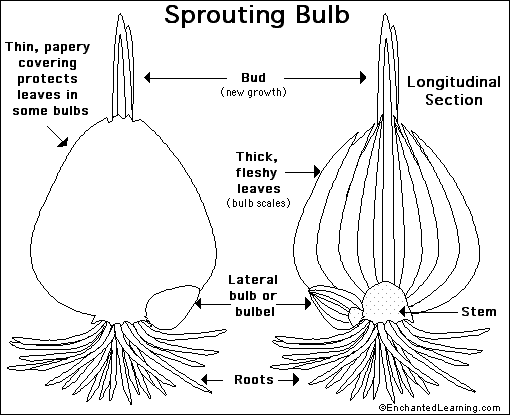Advertisement.
EnchantedLearning.com is a user-supported site.
As a bonus, site members have access to a banner-ad-free version of the site, with print-friendly pages.
Click here to learn more.
(Already a member? Click here.)

The Bulb:
A bulb is an underground, modified stem that develops in some flowering plants. Its purpose is to store food and water for the plant through a cold or dry season. Examples of bulbs include the tulip, narcissus, crocus, onion, lily, and garlic. The smallest bulbs are the size of peas; the largest (crinum lilies) weigh over 15 pounds (7 kg).
Seasonal Cycle:
In plants with bulbs, an underground storage bulb develops during the growing season; the upper part of the plant dies as the weather becomes cold or dry. The bulb remains dormant (living but inactive) underground until the weather warms and water is available. At the start of the new growing season, roots grow from the bottom of the bulb and a bud grows from the stem. The food and water in the bulb tissues nourish the fast-growing bud. The bud develops into a plant that will blossom (producing seeds above ground) and then die back (above the ground) at the end of the growing season; this cycle continues year after year. Many bulbs require a period of low-temperature dormancy before they sprout new buds and roots.
Anatomy:
Bulbs are usually globular and have concentric layers of fleshy leaves covering the short stem. The fleshy leaves store food and water. Roots emerge from the bottom of the bulb at the beginning of the growing season. The bud grows from the apical meristem at the tip of the short stem. Lateral buds (also called bulbels or bulblets) can develop from the base of the existing bulb, producing new, smaller bulbs each year.
Types of Bulbs:
There are two main types of bulbs. One type has a thin paper-like covering that protects its fleshy leaves (for example, the onion). The second type, called a scaly bulb, does not have a papery covering and looks as though it is composed of a group of angular scales (for example, the true lily).
Enchanted Learning Search
|
Search the Enchanted Learning website for:
|
Advertisement.
Advertisement.
Copyright ©2000 EnchantedLearning.com ------ How to cite a web page

